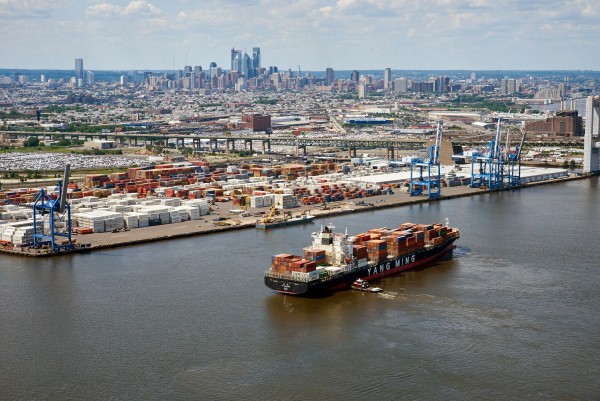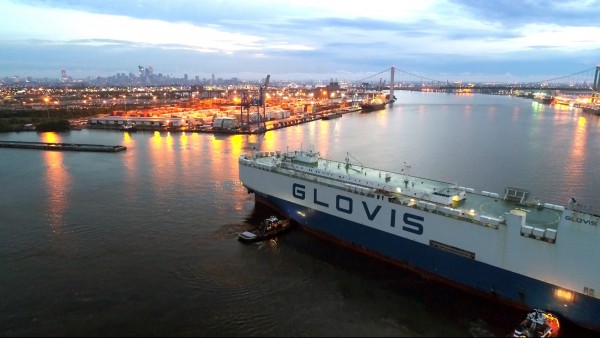Since joining the executive staff at the Port of Philadelphia 26 years ago, Sean Mahoney has never found himself quite as stoked as he is as 2018 begins.
“We really believe we’re on a new footing,” Mahoney, the port’s marketing director, told AJOT, as he cited more than $1 billion in combined investments from public and private sectors in terminal upgrades, a deeper Delaware River channel and other related infrastructure enhancements.
“We see an awakening by BCOs [beneficial cargo owners] and lines that ports like ours can be an alternative to some of the mainstream ports,” Mahoney said. “It’s not just from a savings standpoint but a risk management standpoint of not putting all your eggs in one basket. They’re seeing PhilaPort as a real viable alternative.”
Moreover, the PhilaPort efforts time well with the federally supported $300 million endeavor to bring the 102.5-mile-long main channel of the Delaware River to 45-foot-depth, from 40 feet, as far as Philadelphia’s harbor. The deepening project, launched in 2008, remains on target for completion by spring.
In March, PhilaPort’s Packer Avenue Marine Terminal is slated to celebrate delivery of two new super-post-Panamax gantries – one bought by PhilaPort and the other by Holt Logistics terminal operator subsidiary Greenwich Terminals. Those mammoth gantries are to be operational 60 days later, while two of the terminal’s three existing cranes are being retrofitted to be able to handle larger ships as well. And two more super-post-Panamax gantries, at a cost to PhilaPort of $23.5 million from China’s Shanghai Zhenhua Heavy Industries Co. Ltd., are scheduled to arrive at Packer Avenue in March 2019.

Even before those new big units are in place, PhilaPort was looking to welcome in late January the largest containership ever to call the port – a Mediterranean Shipping Co. vessel with a capacity of nearly 12,000 twenty-foot-equivalent container units transiting the expanded Panama Canal from the West Coast of South America.
Calls by such supersized boxships, combined with expeditious trucking links and CSX and Norfolk Southern intermodal trains, go a long way in helping PhilaPort attract more discretionary cargo headed to Chicago, Ohio and other Midwest markets in addition to goods destined for consumption in closer prosperous consumer markets from Northern Virginia to Boston.
Already, PhilaPort in calendar 2017 for the first time surpassed the half-million TEU milestone in containerized cargo activity, with an anticipated 540,000 or so TEUs far eclipsing the 459,000 TEUs handled in 2016 and positioning the port to attain its ultimate goal of moving 1 million TEUs a year “definitely within less than a decade,” according to Mahoney.
In addition to the larger cranes, the venerable Packer Avenue Marine Terminal is undergoing further upgrades to its infrastructure, from strengthening of wharves to rebuilding of a quay wall to the razing of obsolete warehouses, thanks to a $300 million Commonwealth of Pennsylvania initiative backed by state bonds.
The $300 million pledge made in December 2016 by Pennsylvania Gov. Tom Wolf marked the first major capital commitment to Philadelphia port terminal infrastructure in four decades.
Last June, the landlord port authority invested $10 million in the purchase of a 29-acre property proximate to the Packer Avenue Marine Terminal for development of near-dock cold storage and other warehousing.
At the same time, BCOs have continued to be busy in development of distribution centers throughout Pennsylvania’s Lehigh Valley and in South Jersey, particularly along the stretch of the New Jersey Turnpike between Exit 6 and Exit 4. According to Mahoney, the Lehigh Valley is the second-fastest-growing industrial real estate market in the nation, trailing only Southern California’s Inland Empire.
Among consumer goods coming into PhilaPort are Peruvian fruits, for which Philadelphia is the leading U.S. import port, according to Mahoney.
Breakbulk goods arriving at the Packer Avenue Marine Terminal include cocoa beans from the West Coast of Africa, volume of which was 178,000 tons through the first 11 months of calendar 2017, on pace to be up considerably more than 50 percent from 2016, when 123,000 tons of the chocolate-making ingredient crossed Philadelphia docks.
All told, PhilaPort’s cargo tonnage was on target to reach 6.8 million tons in 2017, up about 10 percent from the preceding year.
With imports of wood pulp on the rise, thanks to shipments by such firms as Brazil-based Fibria Celulose and Chile-headquartered CMPC Celulosa, about $12 million is going toward improvements at PhilaPort’s Tioga Marine Terminal, including construction of a new 100,000-square foot warehouse for forest products, to augment 600,000 square feet of such capacity already in place at Tioga.
PhilaPort is realizing growth on the roll-on/roll-off front as well, with completion in June 2017 of the port’s second auto berth immediately adjacent to Hyundai GLOVIS vehicle processing operations and rail lines. The berth, at Pier 122, gives new life to a riverfront property bought from Conrail a decade earlier.

Concentrating the import and export automotive activity at Pier 122 means car-carrying vessels no longer have to call at Packer Avenue, leading Mahoney to proclaim, “It paves the way for Packer to be what it truly is, which is a dedicated container terminal.”
But PhilaPort brass, led since August 2016 by former Ports America and APL executive Jeff Theobald as executive director and chief operating executive officer, isn’t about to put the brakes on expansion momentum anytime soon. Even though the bid process for long-awaited terminal development on some 200 Southport acres was suspended more than a year ago, eventual hopes encompass building of further berths on smaller tracts of land to the south of the existing Pier 124.





